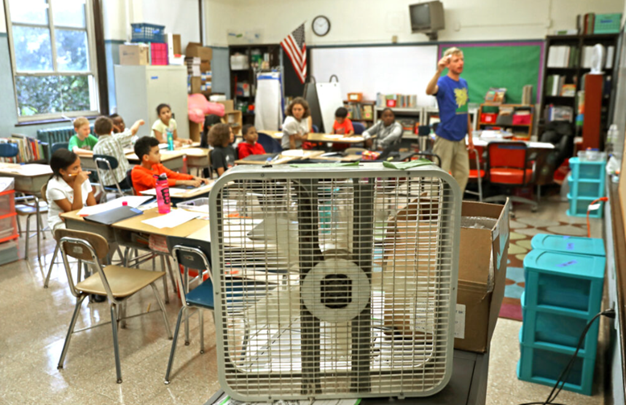
Rising Heat in Schools: A Growing Challenge for Learning
Increasing temperatures are making schools hotter, leading to dehydrated and exhausted students and teachers who are more focused on heat safety than instruction.
Angela Girol, a fourth-grade teacher in Pittsburgh for over two decades, has noticed a significant rise in classroom temperatures, often reaching 90 degrees Fahrenheit. Like many East Coast schools, her classroom lacks air conditioning. On hot days, students often skip meals and do not drink enough water, resulting in frequent visits to the nurse with symptoms like dizziness, headaches, and stomachaches caused by heat and dehydration.
To mitigate the heat, students are now permitted to keep water bottles on their desks, but this brings its own set of challenges. "They're constantly filling up water bottles, so I have to give them breaks during the day for that. And then everyone has to go to the bathroom all the time," Girol explained. This constant disruption leads to a loss of instructional time.
The impact of extreme heat on schools and child care is gaining attention from policymakers and researchers. Recently, the Center for American Progress, a progressive think tank, and the Federation of American Scientists, a nonprofit policy organization, released reports on the issue.
"The average school building in the U.S. is nearly 50 years old," said Allie Schneider, co-author of the Center for American Progress report. Schools and child care centers built in regions that previously didn't need air conditioning are now facing rising temperatures, posing a significant concern for both physical health and learning outcomes. Students are on campus during the hottest parts of the day, which exacerbates the problem.
In April, the U.S. Environmental Protection Agency released a report highlighting how heat affects children, who have more difficulty regulating body temperature and sweat production than adults, making them more susceptible to heat exhaustion and illness. Kids often ignore their body's heat cues, requiring adult supervision to stay hydrated and avoid playing outside.
Kevin Toolan, a sixth-grade teacher in Long Island, New York, shared that constantly monitoring heat safety distracts him from teaching. "The mindset is shifting to safety rather than instruction," he said. To cool the classroom, he turns off the lights, but this makes students sleepy and lethargic.
Some schools have canceled classes due to extreme heat, leading to higher absenteeism, especially among low-income students. Research shows that heat makes learning more difficult. A 2020 study found that students taking the PSAT in schools without air conditioning showed smaller improvements on retakes when outdoor temperatures increased.
Toolan and Girol noted that traditional cooling methods, like opening doors and windows for cross ventilation, are no longer feasible due to increased security measures post-9/11 and concerns about school shootings. This leaves students and teachers in overheated classrooms, with some teachers experiencing migraines or signs of heat exhaustion.
The Center for American Progress and other advocacy groups are calling for federal guidance to ensure children are not forced to learn in dangerously hot conditions. While some states have standards, they vary widely. For instance, California requires child care facilities to maintain temperatures between 68 and 85 degrees, while Maryland recommends 74 to 82 degrees. Florida mandates reduced outdoor activity on high-heat days. Schneider emphasized that federal guidance would help all school districts implement protective standards based on the latest scientific evidence.
In June, 23 health and education advocacy organizations requested the Department of Education to provide better guidance and coordination to protect students from extreme heat. Recommendations included a plan for dealing with high temperatures, encouraging states to allocate more resources for air conditioning, and providing information on heat hazards.
Grace Wickerson, health equity policy manager at the Federation of American Scientists, highlighted the need for a better system to advise schools on best practices, likening the current situation to the "Wild West."
Upgrading school infrastructure, including installing or upgrading HVAC systems, is a long-term solution. The Center for American Progress estimates that by 2025, addressing HVAC needs in schools will cost around $4.4 billion, with 36,000 schools nationwide lacking adequate systems.
Some state and local governments are taking action. In June, the New York State Legislature passed a bill requiring measures like closing blinds and turning off lights when classroom temperatures reach 82 degrees, and canceling classes at 88 degrees. In California, a proposed bill would require schools to create extreme heat action plans, including hydration and rest breaks or moving recess to cooler parts of the day.
Teachers are also advocating for change. As president of the Patchogue-Medford Congress of Teachers, Toolan helped secure $80 million for infrastructure upgrades, with over half allocated for HVAC systems in 500 classrooms in his district. Girol is running for a state representative seat in Pennsylvania, with a key platform to fully fund public schools to pay for air conditioning. She recently received an endorsement from the Climate Cabinet, a federal political action committee. "Part of the reason climate is so important to me is because of this issue," she said. "I see how it's negatively affecting my students."